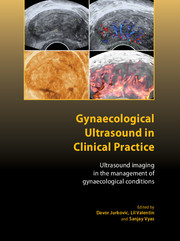 Gynaecological Ultrasound in Clinical Practice
Gynaecological Ultrasound in Clinical Practice Published online by Cambridge University Press: 05 February 2014
Introduction
Postmenopausal bleeding is the most common presentation of malignant disorders of the endometrium. Its prevalence in the general population is estimated to be 40.9% (95% CI 21.8–77.1%) immediately after the first 12 months of amenorrhoea following menopause, falling to 4.2% (95% CI 1.7–10.2%) more than 3 years after menopause. The reported prevalence of malignancy in women presenting with bleeding after menopause varies between 5% and 15%. It is therefore mandatory that all women presenting with postmenopausal bleeding undergo further investigation. Investigation is directed towards differentiating benign from malignant causes of bleeding, in particular maximising the sensitivity for detection of malignancy, while avoiding unnecessary invasive testing and hospital admissions. Women experiencing irregular bleeding on hormone replacement therapy (HRT) also warrant further investigation, although the time interval between presentation and initiation of investigation is less critical as the risk of malignancy is significantly lower in this group (relative risk 1.3%).
The initial assessment of women presenting with postmenopausal bleeding includes a thorough history and examination. Particular attention should be paid to risk factors including advanced age, obesity, infertility, low parity, family history and history of tamoxifen usage.
This chapter reviews current evidence on various investigative modalities and management planning for women presenting to the gynaecology clinic with postmenopausal bleeding and discusses some of the issues to be considered when planning a cost-effective, clinic-based service for these women.
To save this book to your Kindle, first ensure [email protected] is added to your Approved Personal Document E-mail List under your Personal Document Settings on the Manage Your Content and Devices page of your Amazon account. Then enter the ‘name’ part of your Kindle email address below. Find out more about saving to your Kindle.
Note you can select to save to either the @free.kindle.com or @kindle.com variations. ‘@free.kindle.com’ emails are free but can only be saved to your device when it is connected to wi-fi. ‘@kindle.com’ emails can be delivered even when you are not connected to wi-fi, but note that service fees apply.
Find out more about the Kindle Personal Document Service.
To save content items to your account, please confirm that you agree to abide by our usage policies. If this is the first time you use this feature, you will be asked to authorise Cambridge Core to connect with your account. Find out more about saving content to Dropbox.
To save content items to your account, please confirm that you agree to abide by our usage policies. If this is the first time you use this feature, you will be asked to authorise Cambridge Core to connect with your account. Find out more about saving content to Google Drive.